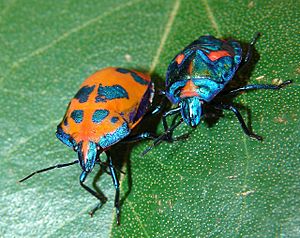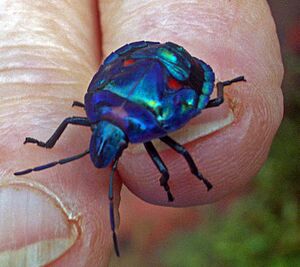Hibiscus harlequin bug facts for kids
Quick facts for kids Hibiscus harlequin bug |
|
|---|---|
 |
|
| Adult female and nymph | |
| Scientific classification | |
| Kingdom: | |
| Phylum: | |
| Class: | |
| Order: | |
| Family: |
Scutelleridae
|
| Genus: |
Tectocoris
|
| Species: |
T. diophthalmus
|
| Binomial name | |
| Tectocoris diophthalmus (Thunberg, 1783)
|
|
| Synonyms | |
|
Cimex lineola Fabricius, 1781 (homonym) |
|
The Tectocoris diophthalmus is a very colorful insect. It is often called the Hibiscus Harlequin Bug or Cotton Harlequin Bug. This bug is the only species in its group, called Tectocoris. It has a rounded, shield-like body and a shiny, metallic look. These bugs can grow to be about 20 millimeters long.
Contents
What Does the Hibiscus Harlequin Bug Look Like?
Adult female bugs are usually orange. Male bugs can be blue and red, or sometimes orange. Young bugs, called nymphs, are typically metallic green and purple.

The colors of these bugs can change a lot! Scientists think that having so many different colors might help them avoid being eaten by birds. Because of all these color differences, scientists used to think they were many different types of bugs. But in 2006, it was confirmed that they are all just one species.
Where Do These Bugs Live?
You can find the Hibiscus Harlequin Bug in Eastern Australia. They also live in New Guinea and on several Pacific Islands. They are common in many places, from cities to farms and coastal areas.
What Do Hibiscus Harlequin Bugs Eat?
These bugs like to eat many plants from the Malvaceae family. This includes plants like hibiscus. They also feed on cultivated cotton plants. Sometimes, they will eat flowers from the Illawarra flame tree. They also enjoy saplings from grevillea and bottlebrush plants.
The bugs pierce the stems of young shoots. Then, they suck out the sap from the plant.
Reproduction and Life Cycle
Female Hibiscus Harlequin Bugs lay their eggs in clusters. They usually place these egg clusters around the stems of hibiscus plants. After laying the eggs, the female bug stays to guard them. She protects the eggs until they hatch.



